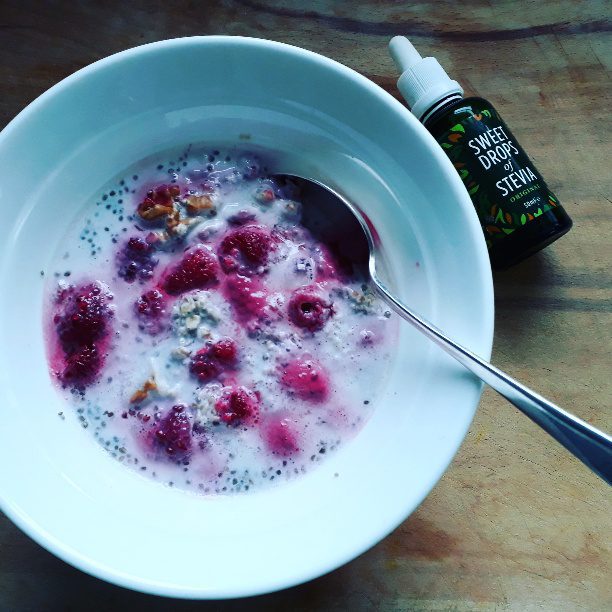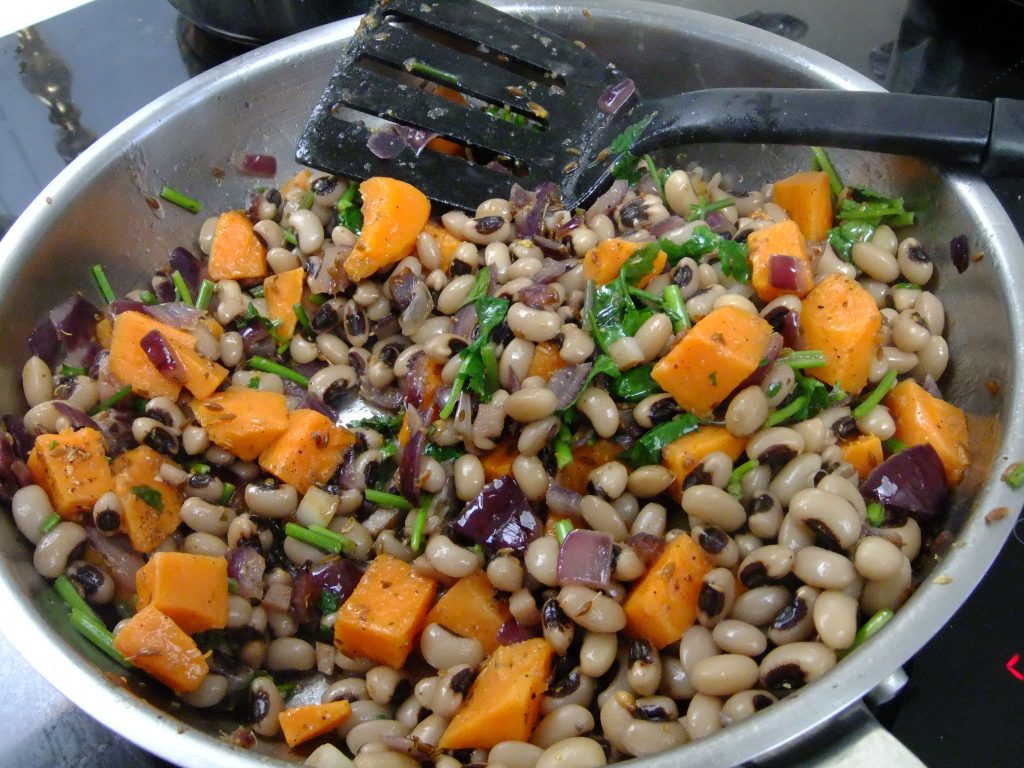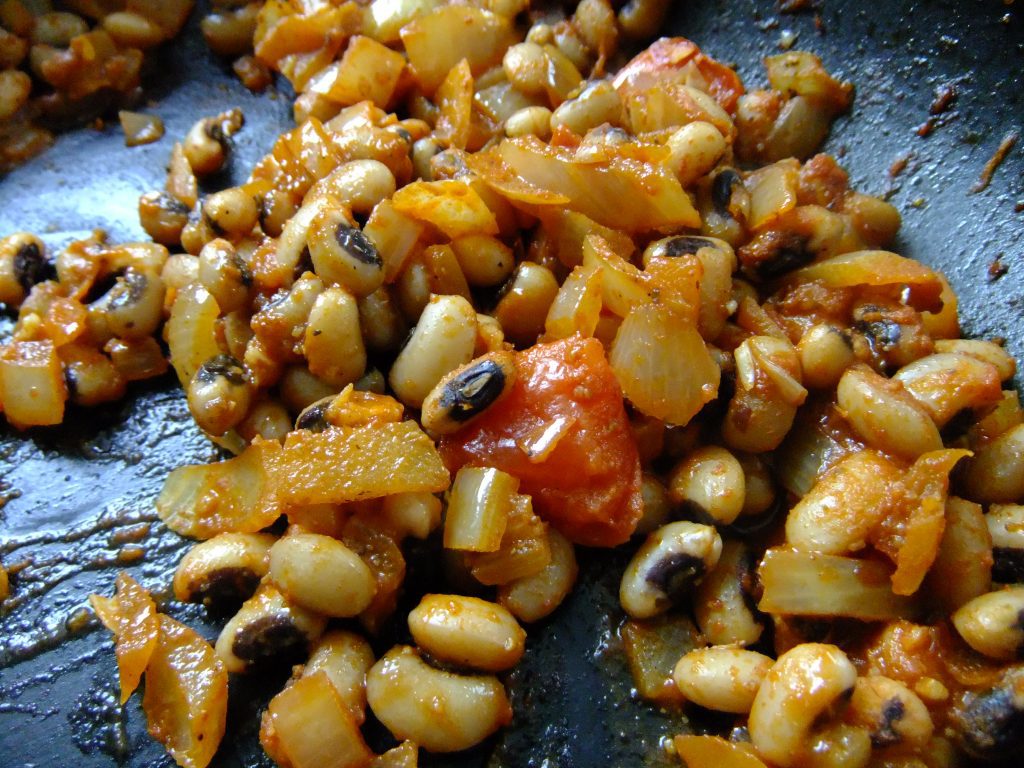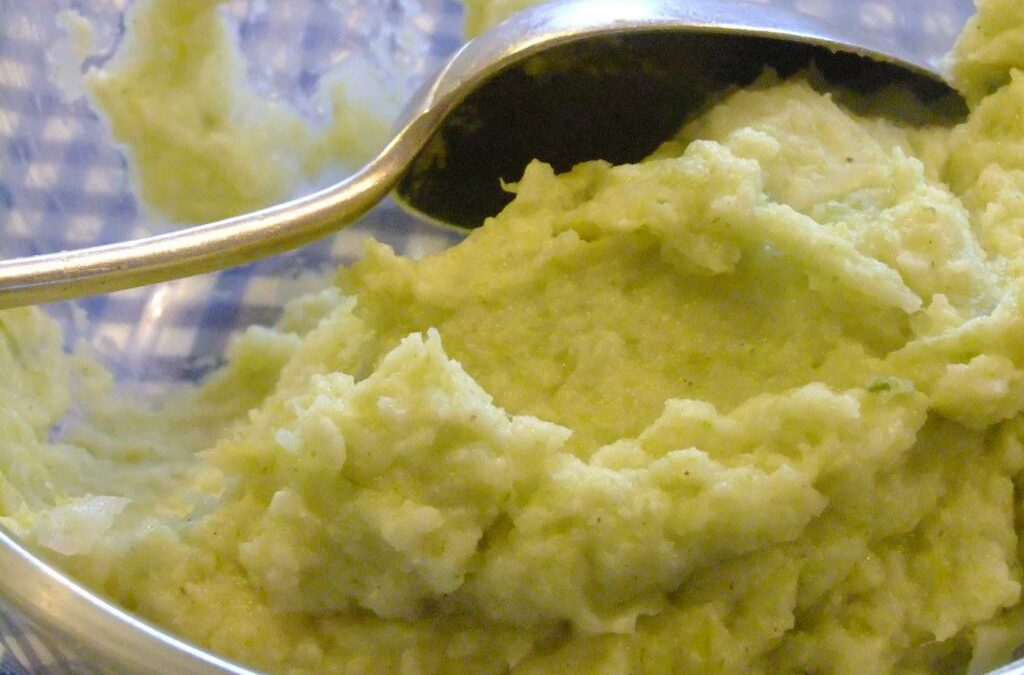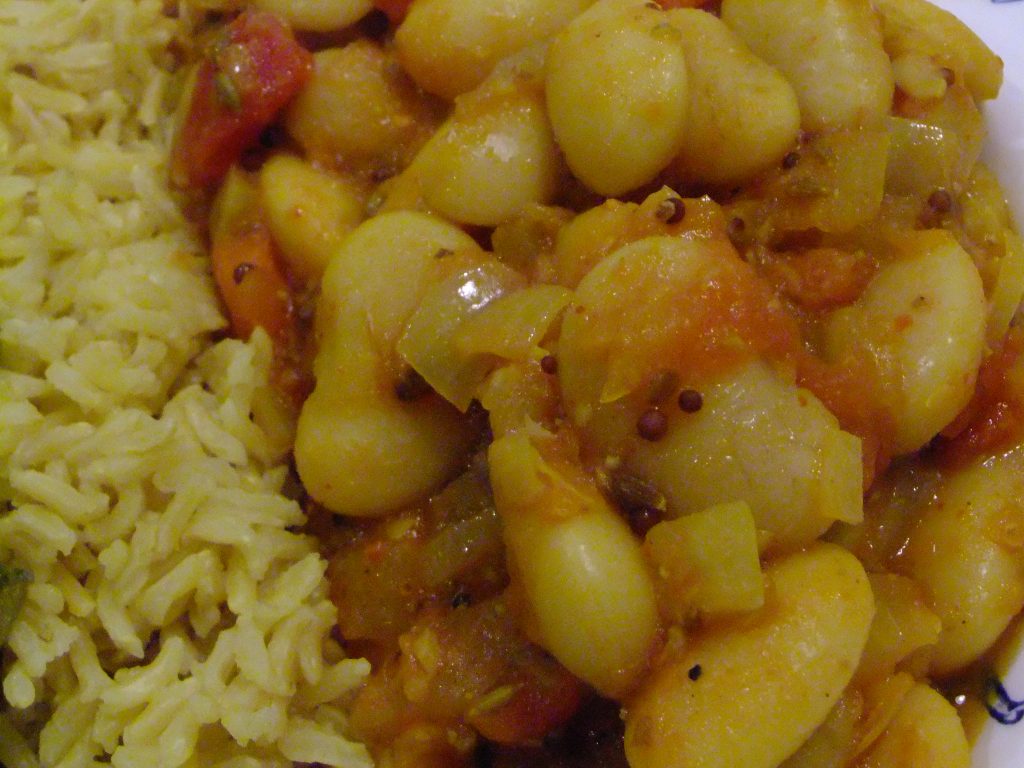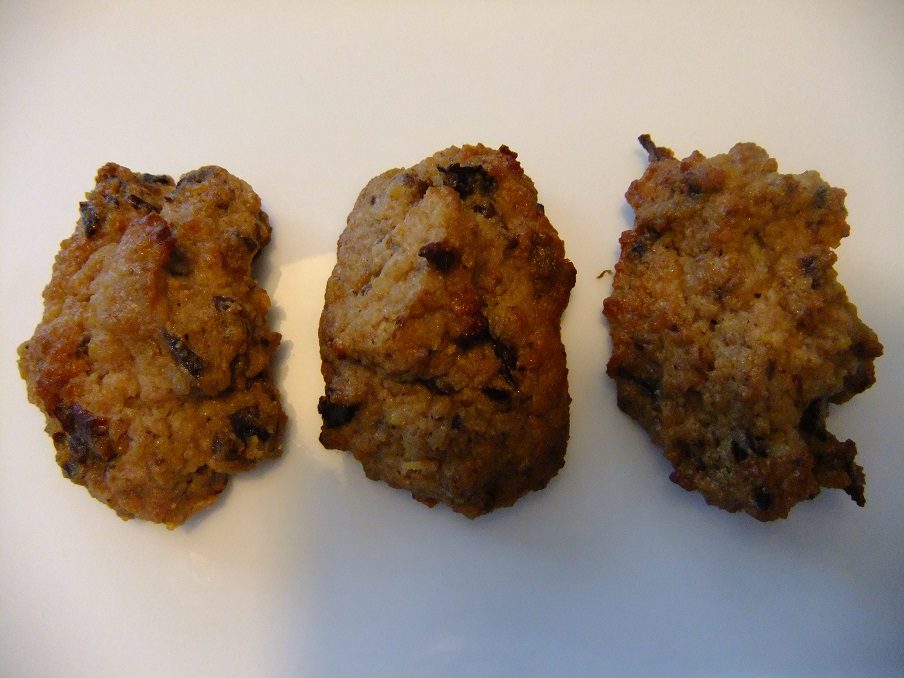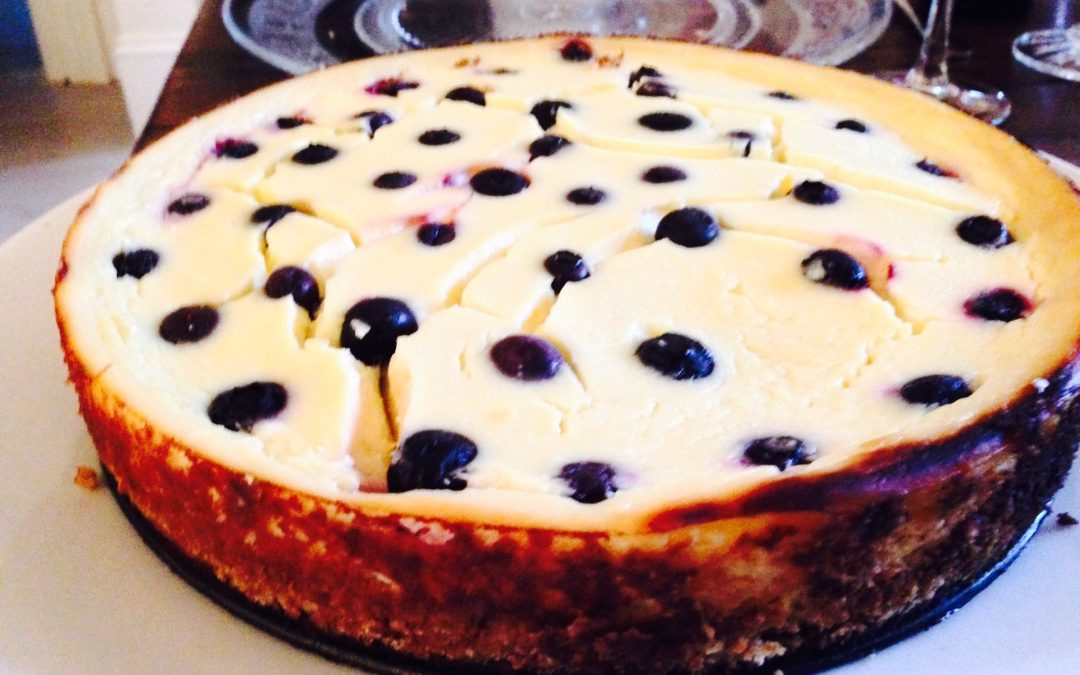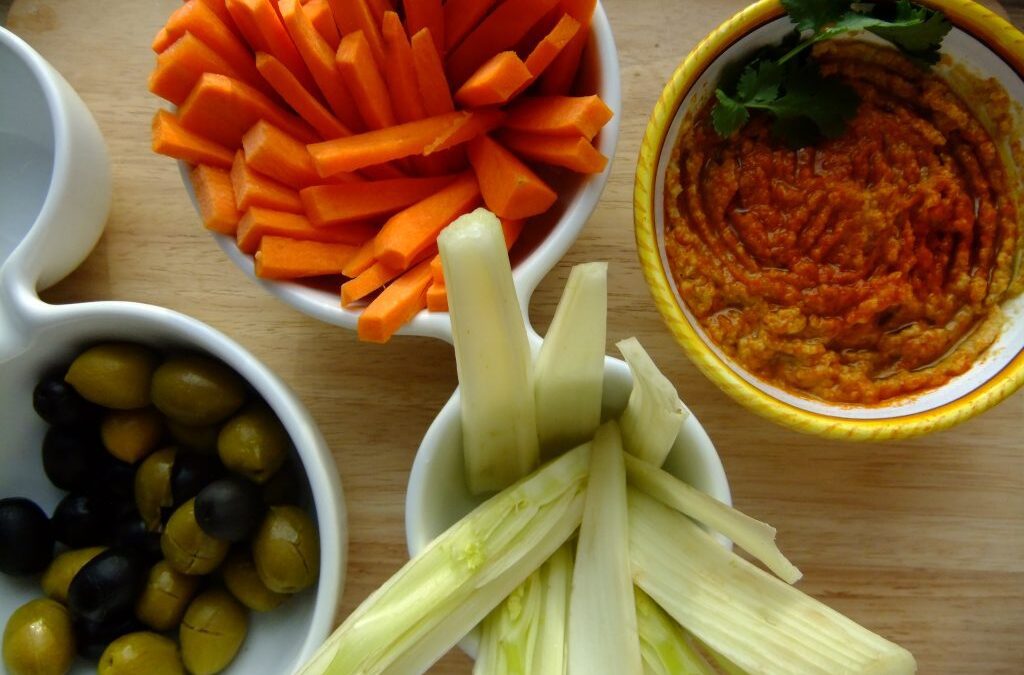
Sep 23, 2016 | Anna's Best Recipes, Breakfasts & smoothies
This is just the thing for when you have a minute in the evening but no time in the morning rush. You can even make it in a glass jar with lid and take it with you to work. I adapted the recipe from one by Derval O’Rourke to have more protein and a lot less starchy carb. So it will keep you going longer and is not a weight-gainer breakfast. If you like this but find it too cool on an autumn morning, you could warm it very gently for a minute or two in a small pan before eating.
For 1:
35g gluten-free oatflakes, about 2/5 of a mug (or normal porridge oats if you eat gluten)
1 heaped tbs (tablespoon) walnuts, roughly broken up, chopped or left whole
1 heaped tbs chia seeds
1 cup frozen raspberries (or use fresh but don’t add until the morning)
10 drops pure stevia (from health stores) – optional
250 ml milk: unsweetened almond milk, thin coconut milk with no additives (or if you prefer goat’s or cow’s milk you can use that but do refrigerate overnight).
1. Put all the ingredients in a large bowl. Mix and cover with a plate or cling film.
2. Allow to stand overnight. If you used cow/goat milk store in the fridge.
3. The next morning, add another splash of milk if you fancy and enjoy.
Why this is good for you:
All grains, even oats, contain phytates. Phytates lock onto nutrient minerals like zinc, forming large molecules that can’t be absorbed into your body. Wheat contains some of the highest levels of phytates. Oats contain fewer but soaking any grain overnight dramatically reduces phytate levels. Raw berries are a powerhouse of polyphenols which help keep your body strong, healthy and young-looking. They even help toughen up a sensitive tummy or help clear your skin. Try to get organic berries if you can. Walnuts and chia seeds provide you with protein to keep you full and when they are soaked their nutrients become more available for your body to absorb. They also contain omega 3 fats and minerals to benefit your body. Unfortunately oats are steamed to make them into oatflakes so this doesn’t qualify as a totally raw breakfast but it’s still great for you.

Sep 12, 2016 | Anna's Best Recipes, Main courses, Packed lunches, Sides, starters, soups & snacks

Bleck-eyed beans with sweet potato and coriander
This is real comfort food and a great crossover dish for feeding vegetarians and carnivores at the same dinner table. It’s pretty rich in protein do if you are feeding a vegetarian its a good choice. But you can also serve it as an accompaniment to roast or grilled meat or fish. I love to eat it as a vegetarian dinner with just a simple green salad or some steamed green/runner beans drizzled with olive oil and paprika. The recipe was I think from Cafe Paradiso but I changed the recipe a bit to use non-toxic oils. Hope you enjoy it. It also works great as a salad in a box to take to work or school.
For 6 as an accompaniment or 3 as a main course
2 medium-sized sweet potatoes, peeled
1 large bunch coriander, stalks and all, chopped
400g dried black-eyed beans (health stores/most supermarkets) soaked in boiling water for 45 minutes
or
2 cans of tinned black eyed beans, drained and rinsed
2 tbs extra virgin oive oil (1 dsp for cooking and 3 dsp for mixing in at the end)
2 large red onions, peeled and sliced or chopped
1½ heaped tsp cumin seeds (the Asia Market good for inexpensive spices)
3 large cloves garlic, peeled and finely chopped
1½ tbs lime juice
¼ tsp Himalayan salt or Atlantic sea salt
1. If using dried beans (and not tinned) , drain the soaked beans and put them into a large pot, adding enough boiling water to cover the beans by a few centimetres, and bring to the boil. Skim off any foam that comes to the surface and cook on a gentle boil for at least 45 mins. Top up with more hot water if it reduces too much. Test the beans to see if they’re cooked and continue until they’re done, when they should be drained, reserving the stock. If using tinned beans, rinse and drain well.
2. Dice the sweet potatoes into ½”/1 cm cubes. Then steam until the point of a knife goes in easily but they are not mushy. Drain carefully and keep the liquid.
3. Place 1 dsp olive oil and 1 dsp water in a large heavy bottomed saucepan, add the onion and cumin and sweat (covered) on a medium heat, stirring occasionally, until the onions are translucent. Add the garlic and cook for another 2 mins. Add the lime juice, bring to the boil, then remove from the heat. Gently mix in the sweet potato, beans, the rest of the olive oil (1½ tbs), coriander, ¼ teaspoon salt, plenty of freshly ground black pepper and ideally leave sit for an hour before serving. This intensifies the flavours.
Why this is good for you:
Extra virgin olive oil, is good for heart health. It contains anti-inflammatory vitamin E, polyphenols and a whole host of other compounds shown to boost our health and vitality. Coriander helps sooth your digestive system and also helps reduce numbers of “bad” bacteria in your digestive system. Too many unhelpful types of bacteria in your gut can cause acne, digestive disorders and even anxiety states and low mood.
Beans are a rich source of magnesium, deficiency of which is linked to stress, constipation, insomnia, anxiety and difficulties with skin health. Refined foods (sugar/white grains), alcohol, stimulants and smoking rob you of magnesium.

Jun 27, 2016 | Anna's Best Recipes, Main courses, Packed lunches
I got this from a newspaper. No idea who wrote the recipe but it’s delicious and so fast, and comforting. It has become a favorite and we often eat it with quinoa and a steamed green veggie for a filling dinner. I often don’t bother with the avocado and yoghurt and it’s still lovely. Also nice as a bean salad served cold, I find.
Bean mixture:
1 large onion, chopped
Extra virgin olive oil
A 400g can of any of these beans: black, black eyed, kidney or borlotti (or mugful/200g dried beans: soak overnight in clean water, drain, cover with boiling water and boil hard till tender – this gives you a larger quantity of beans in the finished dish but it still works)
1 dsp tomato puree
2 cloves garlic, chopped or crushed
1 tsp ground cumin
1 tsp paprika or smoked paprika
To serve:
Little gem lettuce leaves and the following which are optional:
A dollop of natural or Greek yoghurt (if you avoid dairy, use natural soya yoghurt)
Chopped avocado
Lime juice (or lemon juice)
A little Himalayan salt or Atlantic sea salt
- Steam-fry the onion in a dessertspoon of coconut oil and a spash of water. This means covering the pan with a lid or plate, letting the onions steam until translucent and softened).
Add the beans, tomato puree, garlic, cumin and smoked paprika. Simmer 5 minutes. - Spoon into little gem lettuce leaves along with a dollop of (dairy-free or dairy) yoghurt, some chopped avocado, and plenty of lime juice and a little Himalayan salt.
Alternative dinner idea:
Serve with quinoa and a steamed green e.g. broccoli, runner beans or peas.
Packed lunch idea
Bring the leftover bean filling, little gem lettuce leaves, a lime or lemon, and an avocado to work. Reheat the filling (or not), chop or mash the avocado and mix with lemon or lime juice and a little salt. Spoon the filling onto the lettuce leaves and enjoy the avocado mix on the side.
Why this is good for you
Onions and beans contain soluble fibre. This feeds beneficial bacteria in your gut, which are responsible for 80% of detoxification. And scientists used to think that your liver with it’s 5,000+ chemical reactions every day was the main organ of detox! This detox is really important for your skin, your energy and hormone balance – in fact every aspect of your health. Extra virgin olive oil, garlic and spices are anti-inflammatory and help suppress overgrowth of “bad” bacteria in your gut. This can have a dramatically improving effect on digestion and much more…

Feb 17, 2016 | Anna's Best Recipes, Sides, starters, soups & snacks
This mash is a fantastic substitute for mashed potato. I love it because contains more nutrients and much less (natural) sugar and is still delicious. All the comfort of regular mash, none of the downside.
1 small head cauliflower, separated into florets
1 leek, white (and 6cm of green if you like), well washed, cut into 1cm slices
1 knob (about the size of a walnut in its shell) of organic ghee (for people with dairy protein tolerance) or butter or 1 dsp extra v olive oil
2 tbs of unsweetened additive-free non dairy milk like coconut or almond or (if you can eat dairy) you can substitute regular milk or cream
Pinch of ground nutmeg (optional)
¼ tsp freshly ground black or white pepper plus pinch of Himalayan salt/sea salt
1. Steam the cauliflower until softened, then throw the leek in on top and steam everything until very soft. Drain well.
2. Place the vegetables with the milk, ghee/butter and seasonings in the food processor and blitz for a few minutes until smooth. It will have some flecks of green thorough it and look like potato mash.
Tip:
Make lots and store leftovers in the freezer. Reheat over a gentle heat, stirring.
Variation:
Add 2 good tablespoons of chopped parsley when blitzing.
Why this is good for you:
First of all you are getting sulphur from brassica and onion family veg (cauli and leek). This helps your detoxification. Leeks also contain prebiotic fibre which turbo-charges growth of certain good gut bacteria to keep you well. There’s also the major benefit of this mash being much lower in carbohydrates (sugars) than potato mash. Potatoes, especially peeled and mashed are massively high in (natural) sugars which promote blood sugar imbalances when you eat large amounts. Meals very high in carbohydrates slow down our detoxification. Also, because they are satiating, they prevent us from eating lots more vitality-boosting green and non-starchy vegetables in a meal. A seemingly healthy meal of say potatoes, carrots, parsnips and meat is in fact a large sugar overload because the veg are all root vegetables and therefore rich in sugars. Potatoes contain much more sugar than other root veg like carrots. A much more health-supporting combination would be 25% meat, up to 25% starchy carbs (e.g. carrots, potatoes, parsnips, turnips) and 50% or more non starchy vegetables (e.g. green vegetables, cauliflower).

Feb 8, 2016 | Anna's Best Recipes, Main courses
I just discovered this recipe (and adapted it a little to be healthier) by Rose Elliot and its lovely. Just the thing for a cold winters evening. Comfort food at its best. I made extra for leftovers next day or to stick in the freezer.
For 2-3 people
1 mug (200g) dried butter beans or 2 x 400g tins (with no added sugar)
2 tbs virgin coconut oil or ghee
1 large onion, chopped
400g fresh tomatoes, chopped (or half a 400g tin chopped tomatoes)
1 rounded tsp black mustard seeds (if you don’t have any, use 1/2 tsp mustard powder)
1 heaped tsp cumin seeds
2 garlic cloves, crushed or finely chopped
1 tbs raw ginger, grated (peel the ginger first if its not organic)
1/2-1 tsp chilli powder, or to taste
1 heaped tsp ground coriander
1 level tsp turmeric
1/4 tsp asofoetida (a sulphur-rich Indian spice from Asian shops but gluten-sensitive people DO check the ingredient label)
A little water
Fresh coriander, chopped, if you have it
1. Soak the dried beans in lots of clean filtered water overnight. Boil hard for 15 minutes and continue to cook until soft. Drain but keep the liquid and set aside. If using tinned beans, drain and rinse in clean water and set aside.
2. Heat the oil in a heavy bottomed saucepan, add 1 tbs water and sweat the onion (with the lid on) over a medium heat for 10 minutes or until translucent and softened.
3. Add the spices and stir around for a minute or two.
4. Add the tomatoes and garlic and about 50ml of water too. Add the cooked butter beans, stir well and cook the lot together for at least 5 minutes, until the beans are hot. You should have something that is not dry so if it looks like there is not enough liquid to stop everything from sticking, add a little more.
5. Sprinkle with chopped coriander just prior to serving.
Serve with:
Something raw: e.g. a green baby leaf salad, an Indian style salad of chopped tomato, red onion and coriander, or the spinach curry on this blog.
and
Cauliflower rice or (not for SC Diet)
Or
(Not for SC Diet) quinoa/brown basmati rice cooked with a little turmeric
Why this is good for you:
Almost all herbs and spices have huge health benefits. From mustard reducing the pain and irritation of eczema, to chillies healing stomach ulcers by strengthening the stomach lining (and killing pain), to ginger and turmeric as anti-inflammatories that support liver function. Herbs and spices have strong antioxidant properties even at small doses and thousands of scientific research papers keep the evidence stacking up. Butter beans are a lovely source of protein to keep you fuller for longer and reduce your reliance on meat. They take up flavours really well. Just be sure to soak the beans overnight in filtered water before boiling hard for at least 15 minutes, and continuing to cook till tender. Beans contain protease inhibitors – substances that prevent digestion (!). Proper soaking and cooking disables these protease inhibitors, making the nutrients in the beans more available to your body. Nutrients include magnesium, vital for skin, sleep and good mental health. Beans also contain soluble fibre. This feeds good bacteria in your gut responsible for detoxifying hormones and much much more.

Nov 17, 2015 | Anna's Best Recipes, Cakes, biscuits & bars
I love to make these around Christmas-time. They are deliciously moist, flattish but light and are a crowd-pleaser. Prune-haters also usually like these cakes, provided you keep it a secret that they contain prunes! They will keep in an airtight jar in a cool place for about 10 days. I love spices so I generally also add some extra. I add a generous pinch of ground cloves and ground ginger but you don’t have to.
Makes 16 small cakes about 1cm high
60ml water
85g ground almonds
1/2 level teaspoon mixed spice
1 egg white, stiffly beaten
175g pear, peeled
50g dried stoned prunes (with no sulphur dioxide additive), preferably organic, finely chopped
1. Put prunes and water in a small pan and simmer till water is absorbed
2. Combine with the almonds and mixed spice
3. Grate the pear into the almond mixture and stir
4. Fold in the egg white to make a thick paste
5. Place 16 dessertspoonfuls of mix on a greased baking tray
6. Bake 170C (or 155C fan) for 20 mins or until lightly browned
Why these are better for you
First of all these cakes have some high quality protein from the almonds and egg white. This means that the sugars from the pears and prunes only gradually hits your bloodstream (protein slows down absorption of sugars in your gut). This is good news if you like to keep your energy, mood and blood sugar levels fairly even. Sulphur dioxide is a preservative that can have unpleasant effects on your digestive system. Mixed spice, like all spices, contains antioxidants that help reduce inflammation and slow the ageing process. Cooking damages foods, so these are not as healthy as eating raw food (e.g. my raw green tea macaroons on this blog). But sometimes you just want cake anyway…

Oct 13, 2015 | Anna's Best Recipes, Breads, crackers, pancakes & wraps
I am having a craze for recipes that fit in with the specific carbohydrate diet (SCD). The SCD is a lifesaver for so many people with Crohn’s and colitis that I had to start including some of the recipes here and eating them at home sometimes. This bread is really lovely and very easy to make. Just tried it at the weekend with home-made baked beans for breakfast and a piece of fruit to follow. Naturally I also smothered it in my home-made buttery spread for bread but you could use normal butter or ghee (clarified butter). Wish I could say the recipe is my own, but I found it in the wonderful SC diet cookbook. I did reduce the (I thought) excessive amount of salt from the original recipe and it still tasted great. This bread is suitable for a grain-free ketogenic diet as well – AND IS TOTALLY DELICIOUS AND SATISFYING.
900g (2lb) loaf tin
2 large eggs (if they are tiny, you could use 4)
230ml (1 cup) home made kefir or home-made natural yoghurt (see SC diet website)
28g clarified butter or ghee or (if you are not dairy sensitive) normal butter, melted
½ level teaspoon sea salt or Himalayan salt
1 rounded teaspoon baking soda (“bread soda” is another name for this)
½ teaspoon freshly ground black or white pepper
385g almond flour (ground almonds are fine. The finer ground the better – I whizzed mine in the food processor for a bit before adding the other ingredients)
12g (1/4 cup) chopped chives (do use these, they give a fab flavour – if you don’t have any you could use the green parts of spring onions chopped up finely)
14g finely chopped, dry, sun-dried tomatoes (with no additives if you are on SC diet)
1. Preheat oven to 170C (fan oven) or 195C otherwise. Grease and bottom line a 900g (2lb) loaf tin with baking parchment.
2. Blend together all ingredients in a food processor then pour into the tin.
3. Bake in the oven for 45-55 mins until a knife inserted into the centre comes out clean.
4. The bread, once cool, should keep well in a self seal bag or airtight container in the fridge for at least 5 days.
Why this is better for you:
Some people need to follow a grain-free diet in order to stay well. This recipe is just the thing to satisfy the longing for bread. This bread would be brilliant for anybody needing a low carbohydrate diet (e.g. people with diabetes, or people following a ketogenic diet to manage cancer). Being baked, its naturally not quite as healthy as eating the nuts (almonds) raw. But what the hey, sometimes you just want bread. Because the bread is very low in carbohydrates (sugars) its a great substitute for the wheaten bread that can cause such huge dips in energy after lunch. And of course its low GI and studies show low GI eating helps skin and hair health too. You might wonder why I mention “dairy-free” when the recipe contains ghee/clarified butter – this is because when you clarify butter you remove the lactose (milk sugar) and casein (problematic milk protein) and so it becomes hypoallergenic. Great news for anyone who is dairy sensitive. If you have a true dairy allergy (throat swelling, anaphylactic shock) you will of course still want to steer clear of any contact with dairy products whatsoever, even during food preparation for others.

Jul 8, 2015 | Anna's Best Recipes, Desserts & drinks
I got this lovely recipe from Linda McFarland. Everyone loves it and no-one notices it’s healthier than standard sugar-laden gluten-laden cheesecake.
Serves 8
For the base:
50g virgin coconut oil
170g Nairns gluten-free unsweetened oatcakes (you can use normall 100% oat rough oatcakes if you are not gluten-sensitive/coeliac)
35g xylitol or (even better) erythritol
1 rounded tsp ground ginger
¼ level tsp Himalayan/Atlantic sea salt
For the cheesecake topping
3 lemons, organic or washed well with hot soapy water and rinsed
250g tub ricotta cheese
200g Greek yoghurt (sheep/goat)
4 eggs, ideally organic
1 tbs cornflour
70g xylitol
1 punnet fresh blueberries
1 x 23cm/9in round springform cake tin
1. Preheat oven to 175C/160C fan.
2. Melt the oil or butter gently in a saucepan and while this is happening crush the oatcakes to small crumbs.
3. When butter/oil is melted, add crushed oatcakes, xylitol, the ginger and salt and mix well.
4. Press in to the bottom of the tin and chill in the fridge.
5. Next, zest and juice the 3 lemons into a large bowl, mix in the ricotta cheese, the yoghurt, eggs, cornflour and 70g xylitol and whisk well until smooth. The mixture will be quite thin.
6. Pour the mixture into the tin, sprinkle the blueberries over (they will float on the top) and bake for around 40 minutes until firm.
Cool and run a knife around the inside of the tin before releasing. Serve with a berries on the side.

Why this is better for you:
This recipe uses xylitol or erythritol instead of sugar. Xylitol is a health shop sweetener that looks and tastes like white sugar but doesn’t rob your body of nutrients. It is safe for diabetics and doesn’t cause weight gain either. This is because it doesn’t affect your blood sugar levels. Because the base is made with oatcakes instead of the normal wheat biscuits it is much kinder to your digestive system (even if you are not sensitive to gluten). The insoluble fibre in wheat is an intestinal irritant. Virgin coconut oil is a good source of medium chain triglycerides which are helpful for boosting energy and are really easy to digest. Lots of people are sensitive to dairy (milk) products. This recipe uses goat/sheep yoghurt and ricotta so it is lower in milk allergens like casein, which cause problems for so many people. Lemon zest and juice helps detoxification – just the thing if you have had a rich meal and a few too many glasses of wine….

Apr 30, 2015 | Anna's Best Recipes, Dressings, rubs, spreads, sauces & more, Sides, starters, soups & snacks

Middle Eastern tahini dip with crudites
This is based on a Sophie Grigson recipe I loved, but lost. My husband says this version is the best of my attempts to recreate it. It’s dead simple. Enjoy with strips of red pepper, carrot, cucumber or celery and maybe a few olives. Dips with veg sticks before a main course are a great way of encouraging your kids to eat veggies too – take advantage of them being hungry!!
For a smoother dip use normal tahini made from roasted sesame seeds. For a coarser (and even more vitality boosting) dip use raw tahini (e.g. Carly’s) from health shops. Raw seeds retain their beneficial oils to do your body even more good. If you’re not going to use this dip within half an hour or so, store in a small screwtop glass jar or else a small glass/ceramic container with clingfilm over the top (but not in contact with the dip itself) to stop it drying out.
To make this dip into a sauce add a little more water to thin and drizzle over cooked white fish or felafels.
To serve 3-4 as a starter
2 cloves garlic
2 level tbs dark tahini
1 1/2 tbs lemon juice
1 dsp extra virgin olive oil
1 level tsp cumin
Pinch Himalayan or Atlantic sea salt
Pinch cayenne pepper
4 tbs water
Mini food processor method:
1. Crush the garlic and throw it and the rest of the ingredients into a mini food processor.
2. Blend for a couple of minutes, scraping down the sides of the processor a few times to get everything well mixed.
3. If you have time, allow to sit for half an hour for the flavours to amalgamate.
Traditional method:
1. Crush the garlic and place in a mixing bowl with everything except the water.
2. Mix well with a wooden spoon, then add half the water. The tahini will become quite stiff at this point, just keep mixing and it will start to relax and absorb the water.
3. Mix well, then add the rest of the water and work till smooth. This will be a more rustic mix than using the food processor. If you have time, allow to sit for half an hour for the flavours to amalgamate.
NB. If you are on a ketogenic eating plan, avoid eating more than 1/2 cup raw carrots in the day. Like all root veg, they are rich in sugar and too many will derail your programme.
Why this is good for you:
Garlic is a fantastic booster for your whole body. It kills yeast infections and overgrowths of pathogenic (“bad”) bacteria in your gut. This is good news if you want to sort out your digestion or achieve beautiful skin. Garlic’s sulphur compounds also support your liver to clear chemicals, used-up hormones and other toxins out of your body. Skin conditions are usually largely due to problems in the digestive system. Sort those out and you have dont more than 90% what you need to do. If you are not used to eating garlic, especially raw garlic, start with a little and gradually build up. Garlic is in my top 10 vitality boosting foods. Spices like cumin and cayenne pepper also have great benefits – anti inflammatory, anti-ageing and more. Have you had your spices today?

Apr 22, 2015 | Anna's Best Recipes, Sides, starters, soups & snacks
If you like both Thai food and Spanish gazpacho you will love this recipe by Domini Kemp. I think it’s fantastic. Have it as a filling snack, as a starter or with some chicken or fish and a little green salad for a main meal. If you don’t like cold soups, then this can be heated very gently until only just lukewarm.
For 4-6 servings
For the soup:
400ml tin full fat coconut milk (go for organic from health shops – free from chemical emulsifiers and BPA in tin linings)
1 large ripe avocado
2 large tomatoes, cut into rough chunks
2 large cloves garlic, peeled and crushed
Big knob ginger
1 large tbs (25g) non-gmo miso paste from a jar or vacuum pack (if you are gluten-free then brown rice miso is best, or hatcho miso)
Juice of 2 limes and 2 lemons
1 courgette, sliced
1 red chilli, de-seeded and sliced
Big bunch each coriander and basil
1 tbsp Thai fish sauce
Black pepper to taste
For garnish:
1 red onion, very finely chopped
Fresh coriander
- Blitz everything except the garnish ingredients in a liquidiser or food processor to form a smooth soup.
- Pour into bowls and sprinkle the finely chopped red onion and coriander on top.
Why this is great for you
The raw miso in this soup is packed with beneficial bacteria so important for your skin, digestion and even your mood. Heating above 45C would destroy these good bacteria so the fact the soup is raw is brilliant. Beneficial bacteria help your body to clear used-up hormones such as testosterone and oestrogens, help repair your intestines and make digestive enzymes and even control your mood and how your skin looks. Coriander, lemon, lime and garlic actively help your liver and gut clear normal (and abnormal) toxins out of your body. In our chemical-laden modern world, this is good news. Coconut milk contains capryllic acid, which, like raw garlic, helps to kill off excessive pathogenic yeasts (eg candida albicans). Fresh coriander also binds to heavy metals (like mercury from dental fillings) and escorts them safely out of your body via your bowel.
